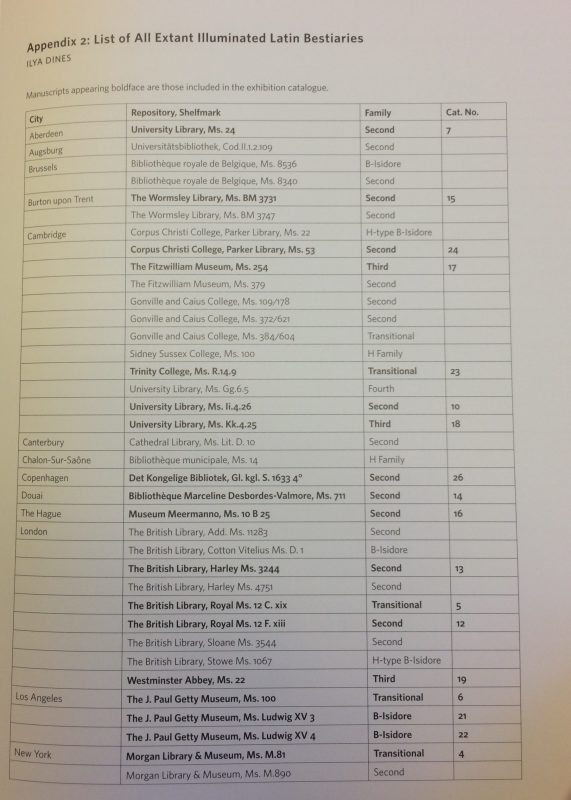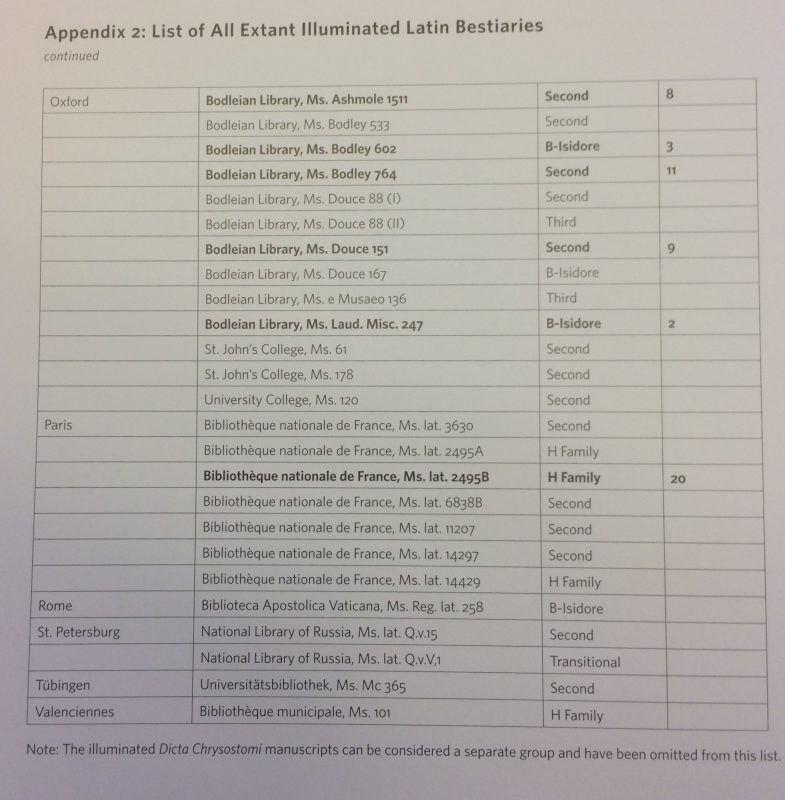This is an idiosyncratic, selective, introductory bibliography and webography about and around bestiaries. It might be useful as a starting-point to people who are interested in reading and learning more.
LAST UPDATED: 2019-11-21
I. BESTIARIES
Some Wikipedia articles on bestiaries and their bookish relatives, terms, and environment; often with links to online texts and translations; selected for relevance to this course’s environment—the “Romance world: medieval to early modern” of the course title—and as background to its central readings, Marie de France’s Lays and Michel de Montaigne’s Essays:
- Aristotle’s biology:
- Bartholomaeus Anglicus / Bartholomew the Englishman, De Proprietatibus rerum
- bestiary
- bestiaries: [a] list of medieval bestiaries
- book of hours
- encyclopaedia
- Frederick II, De arte venandi cum avibus
- Guillaume le Clerc, Bestiaire divin
- herbal
- Hildegard of Bingen, Physica
- illuminated manuscript
- Isidore of Seville
- Etymologiae book XII
- fables
- Physiologus
- Pliny the Elder, Naturalis historiae
- psalter
- Richard de Fournival, Bestiaire d’amours
- Vincent of Beauvais, Speculum naturale
Some bestiary sources (in English):
David Badke, ed., The Medieval Bestiary: Animals in the Middle Ages > http://bestiary.ca
Ron Baxter, Bestiaries and their Users in the Middle Ages (Thrupp: Sutton Publishing; London: Courtauld Institute, 1998).
Willene B. Clark, The Medieval Book of Birds: Hugh of Fouilloy’s Aviarium; Edition, Translation and Commentary (Binghamton, NY: Center for Medieval and Early Renaissance Studies, 1992).
—. A Medieval Book of Beasts: The Second Family Bestiary; Commentary, Art, Text and Translation (Woodbridge: Boydell and Brewer, 2006).
Meredith Cohen, “The Bestiary beyond the Book,” in Elizabeth Morrison, ed. Book of Beasts: The Bestiary in the Medieval World, “Part Three: Beyond the Bestiary” (Los Angeles: J. Paul Getty Museum, 2019): 177-83.
Ilya Dines, “The function of Latin Bestiaries in Medieval Miscellanies,” in Morrison Book of Beasts “Part Two: Exploring the Bestiary” (2019): 67-74.
Larissa Grollemond, “Beasts at Court: Reading the Bestiary in the Late Thirteenth Century,” in Morrison Book of Beasts, “Part Two: Exploring the Bestiary” (2019): 157-74.
—, “The Bestiary in the Modern Age,” in Morrison Book of Beasts, “Epilogue: Legacy of the Bestiary” (2019): 283-307.
Debra Hassig, Medieval Bestiaries: Text, Image, Iconography (Cambridge: Cambridge University Press, 1995).
—, The Mark of the Beast: The Medieval Bestiary in Art, Life, and Literature (New York: Garland, 1999).
Isidore, Etymologies. The Etymologies of Isidore of Seville. Trans. Stephen A. Barney, W.J. Lewis, J.A. Beach, and Oliver Berghof. Cambridge: Cambridge University Press, 2006.
M.R. James, The Bestiary: Being a Reproduction in Full of the Manuscript Ii.4.26 in the University Library, Cambridge, with Supplementary Plates from other Manuscripts of English Origin, and a Preliminary Study of the Latin Bestiary as Current in England (Oxford: Roxburgh Club, 1928).
Sarah Kay, “The Textual Kaleidoscope of the Medieval Bestiary,” in Morrison Book of Beasts “Part Two: Exploring the Bestiary” (2019): 31-37.
Florence McCulloch, Medieval Latin and French Bestiaries (Chapel Hill: University of North Carolina Press, 1962).
Elizabeth Morrison, ed. Book of Beasts: The Bestiary in the Medieval World (Los Angeles: J. Paul Getty Museum, 2019). From the May-August 2019 exhibit of the same name, https://www.getty.edu/art/exhibitions/bestiary/
—, “Accommodating Antlers, Making Room for Hedgehogs, and Other Problems of Page Design in the Medieval Bestiary,” in Morrison Book of Beasts, “Part Two: Exploring the Bestiary” (2019): 51-65.
Emily Steiner, “Encyclopedic Beasts,” in Morrison Book of Beasts, “Part Three: Beyond the Bestiary” (2019): 237-59.
SOME MEDIEVAL BESTIARIES ONLINE
David Badke, The Medieval Bestiary > “Manuscripts by location” http://bestiary.ca/manuscripts/manulocshelf.htm offers a comprehensive list of manuscripts online, by location (ex. Aberdeen) and shelf mark (ex. Univ. lib. MS 24). For example: The Aberdeen Bestiary (Aberdeen University Library, MS 24)
Ilya Dines “Appendix 2: List of All Extant Illuminated Latin Bestiaries,” in Morrison Book of Beasts (2019): 309.
SOME MODERN BESTIARIES
Jorge Luis Borges, The Book of Imaginary Beings, trans. Andrew Hurley (London: Penguin, 2006); first published in Spanish as Manual de zoología fantástica (1957), expanded to El libro de los seres imaginarios (1968); and see https://en.wikipedia.org/wiki/Book_of_Imaginary_Beings
Ann VanderMeer, ed. The Bestiary (Lakewood, CO: Centipede Press, 2015).
II. ECOCRITICISM AND ANIMAL STUDIES
Some Wikipedia articles:
- animal studies
- anthrozoology
- critical animal studies
- cryptozoology
- ecocriticism
- ethnobiology
- posthumanism
Some critical and theoretical works:
D.L. Ashliman, Folklore and Mythology Electronic Texts. https://www.pitt.edu/~dash/folktexts.html: intersections of folklore, oral culture, anthropology, popular culture, literature (geographically and culturally limited but a starting point)
Association for the Study of Literature and Environment, “Definitions of ecocriticism archive: chronicles the emergence of ecocriticism as a field of study—from the founding of ASLE in the early 1990s to 2009.” https://www.asle.org/explore-our-field/ecocriticism-and-environmental-humanities/definitions-of-ecocriticism-archive/. “ASLE seeks to inspire and promote intellectual work in the environmental humanities and arts. Our vision is an inclusive community whose members are committed to environmental research, education, literature, art and service, environmental justice, and ecological sustainability.”
Bénédicte Boisseron, Afro-Dog: Blackness and the Animal Question (New York: Columbia University Press, 2018).
E. Jane Burns and Peggy McCracken, eds., From Beasts to Souls: Gender and Embodiment in Medieval Europe (Notre Dame, ID: University of Notre Dame Press, 2013).
Mel Y. Chen, Animacies: Biopolitics, Racial Mattering, and Queer Affect (Durham, NC: Duke University Press, 2012).
Sarah Cockram and Andrew Wells, eds., Interspecies Interactions: Animals and Humans between the Middle Ages and Modernity (London: Routledge, 2018).
Jeffrey Jerome Cohen, ed., Monster Theory: Reading Culture (Minneapolis: University of Minnesota Press, 1996).
—and other works in ecocriticism, ecotheory, and environmental thinking
Donna Haraway, Staying with the Trouble: Making Kin in the Chthulucene (Durham: Duke University Press, 2016).
Bruce Holsinger, “Of Pigs and Parchment. Medieval Studies and the Coming of the Animal,” Publications of the Modern Language Association 124.2 (2009): 616-23.
—, “Written on beasts,” New York Review of Books (25 November 2015) at https://www.nybooks.com/daily/2015/11/25/parchment-beasts/
—and other articles about parchment, animal skin, and bioarchaeology: see for example publications list at https://english.as.virginia.edu/people/profile/bh9n
Sarah Kay, “Legible skins: Animals and the ethics of medieval reading,” in postmedieval 2.1 “The Animal Turn” (2011), online at https://link.springer.com/journal/41280/2/1
—Animal Skins and the Reading Self in Medieval Latin and French Bestiaries (Chicago: University of Chicago Press, 2017).
Damien Kempf and Maria L. Gilbert, Medieval Monsters (London: British Library, 2015).
Alison Langdon, ed. Animal Languages in the Middle Ages: Representatives of Interspecies Communication (New York: Springer, 2018).
Scott McCloud, Understanding Comics (New York: HarperCollins, 1993) has amongst many things a brilliant section on faces (human, smiley, etc.); see also his other works, Reinventing Comics (New York: HarperCollins, 2000) and Making Comics (New York: HarperCollins, 2006). Related: the idea (robotics) of the uncanny valley.
Peggy McCracken, In the Skin of a Beast: Sovereignty and Animality in Medieval France (Chicago: University of Chicago Press, 2017).
Peggy McCracken and Karl Steel, eds. postmedieval 2.1 “The Animal Turn” (2011): journal special issue, online open access at https://link.springer.com/journal/41280/2/1
Louisa Mackenzie and Stephanie Posthumus, eds., French Thinking about Animals (East Lansing: Michigan State University Press, 2015).
Asa Mittman, The Ashgate Research Companion to Monsters and the Monstrous (Abingdon: Routledge: 2013).
—and other works on monsters and monstrosity: see https://asamittman.wordpress.com/publications/
Aaron M. Moe, Zoopoetics: Animals and the Making of Poetry (Lanham: Lexington Books, 2014).
Œcologies scholarly resources: medieval > https://oecologies.com/resources/scholarly-resources/#medieval
Anselm Oelze, Animal Rationality: Later Medieval Theories 1250-1350. Investigating Medieval Philosophy series, vol. 12 (Leiden: Brill, 2018)
Stephanie Posthumus, French Écocritique: Reading Contemporary French Theory and Fiction Ecologically (Toronto: University of Toronto Press, 2017).
RMST 221B “Animal Reading” resources on Twitter (ecosystemically organised, a.k.a. in no obvious particular order) @Rmst221b
–and collected together (with the same parenthetical comment) through the hashtag #rmst221b (which also includes things that I forgot to talk about in class; consider them outtakes…)
Joyce E. Salisbury, The Beast Within: Animals in the Middle Ages, 2nd ed. (Abingdon: Routledge, 2011).
Karl Steel, How to Make a Human: Animals and Violence in the Middle Ages (Columbus, OH: Ohio State University Press, 2011).
—How Not to Make a Human: Pets, Feral Children, Worms, Sky Burial, Oysters (Minneapolis: University of Minnesota Press, December 2019).
—more animal studies, posthumanism, and biopolitics: https://www.brooklyn.cuny.edu/web/academics/faculty/faculty_profile.jsp?faculty=675
—blog: for example https://medievalkarl.com/2019/05/01/be-reasonable-animality-and-personifications-of-reason-loosely-through-langland/
Nancy K. Turner, “The Materiality of Medieval Parchment: A Response to ‘The Animal Turn’.” Revista Hispánica Moderna 71, no. 1 (2018): 39-67.
Katie L. Walter, ed., Reading Skin in Medieval Literature and Culture (New York: Macmillan, 2013).
Kari Weil, Thinking Animals: Why Animal Studies Now? (New York: Columbia University Press, 2012).
Cary Wolfe, Before the Law: Humans and Other Animals in a Biopolitical Frame (Chicago: University of Chicago Press, 2015).
III. AND MORE
Elizabeth Morrison, ed. “References,” in Book of Beasts: The Bestiary in the Medieval World (Los Angeles: J. Paul Getty Museum, 2019): 315-29. PDF of photos.

